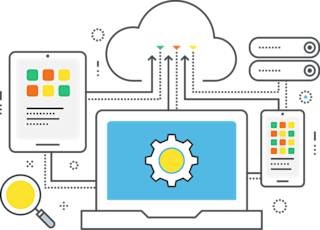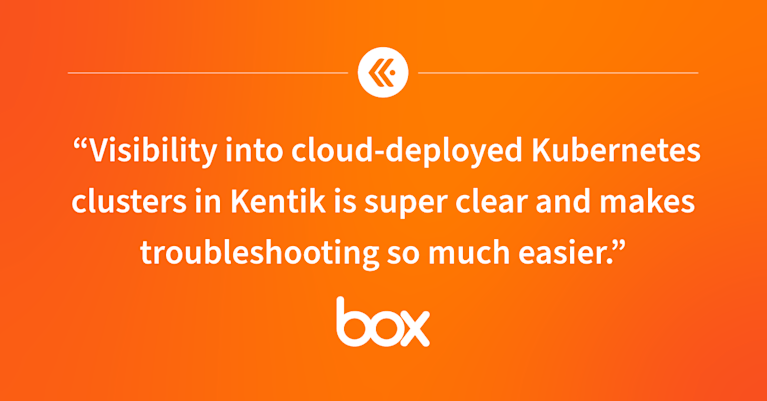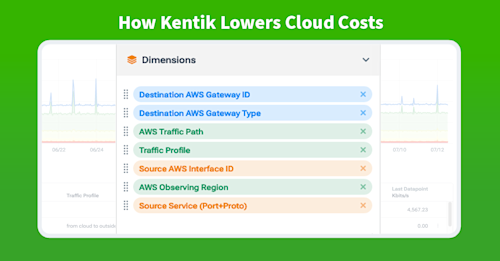What is Cloud Networking?
Businesses continue to be impacted by the cloud computing wave. Traditional networks with on-prem servers, routers, and switches can no longer compete with the scalability, reliability, or security that cloud computing offers. For many public and private organizations, the services and customer experiences they deliver have moved to the cloud. This migration to the cloud has introduced a superfluity of terms and acronyms.
When first learning about the world of cloud services, it is easy to get confused or even start using terms interchangeably that actually have different meanings. To keep terms delineated, consider creating a personal glossary. This article is intended to clarify the confusion around cloud networking.

Cloud Networking Definition
Cloud networking is an IT infrastructure where an organization’s network and resources are hosted in a public or private cloud platform and are available on demand using only an internet connection. Hosting networking resources on the cloud may involve using devices on-premises or through a cloud service provider and can include the following networking services:
- network management and access software
- connectivity
- virtual routers
- firewalls and security services
- load balancers
- bandwidth
- content delivery networks (CDNs)
- virtual private networks (VPNs)
Cloud Networking vs. Cloud Computing
When the preceding word “cloud” is removed from both networking and computing, the two terms immediately take on different meanings.
-
Cloud networking is when network resources and capabilities are hosted in the public, private, or hybrid cloud. These resources include virtual routers, switches, load balancers, firewalls, bandwidth, network management, and more. They are available on demand and can be managed in-house or by a third party. Just as the command line interface (CLI) on Cisco router interfaces differs from Juniper’s, the same applies when configuring network gear in the cloud between virtual private clouds (VPCs). Cloud networking equates to the cloud infrastructure used to power connectivity between resources, and it is built on cloud computing.
-
Cloud computing is a broader term for overall centralized computing resources that are shared by numerous customers. Collectively, it encompasses all services provided by the cloud that are required to keep applications up and running, including compute, storage, and networking. It’s more of an umbrella term that encompasses cloud networking.
Cloud Networking Types
- Cloud networking: An umbrella term for IT infrastructure that connects all variations of on-premises, edge, and cloud base services.
- Multicloud networking: A type of cloud networking with advanced capabilities integrated with public cloud providers, resulting in smoother accessibility across multiple clouds and on-premises environments.
- Hybrid cloud networking: A subset of cloud and multi-cloud networking that refers specifically to the connectivity between two different types of cloud environments, such as on-premises private, hosted private, and public clouds.
- Cloud networking and cloud-based networking: A cloud networking solution with their control plane hosted and delivered in public clouds instead of an on-premises device.
Popular “as-a-Service” Models
Cloud computing — or simply “cloud” — includes several other computing areas beyond networking. Below are a few of the more common terms to get familiar with:
- Infrastructure as a Service (IaaS): The cloud provider offers access to “raw” computing resources, such as servers, storage, and networking. The customer is responsible for the platform and application software.
- Platform as a service (PaaS): A development environment that supports the lifecycle of application building, managing, testing, and deployment. Third-party service providers or enterprise clients manage the servers, storage, and networks. PaaS eliminates the need for businesses to build a dedicated platform.
- Software as a Service (SaaS): Software used via the cloud that may or may not be installed on a local computer. SaaS applications reside on the cloud network, and users can store and analyze data and collaborate on projects through the application.
- Functions as a Service (FaaS): Serverless functions hosted in the cloud (e.g., AWS, Azure Functions, Google Functions, Oracle Cloud Functions). What’s neat about these services is that they cost nothing when not running.
- Hardware as a Service (HaaS): The user leases equipment under a service level agreement (SLA). At the end of the leasing period, the lessee may have the option to purchase it for a fee or send it back.
Transitioning to cloud quickly complicates networking. Learn the top 3 AWS gotchas and how to avoid them.

Cloud Networking and Computing Benefits
The cloud brings many benefits to both small and large businesses. Here are a few key areas:
- Applications can be rolled out much more rapidly as servers are readily available. This accelerates time to market.
- Shared networking resources mean if the overhead is lightweight, compute is reduced, and therefore a savings is gained.
- Bandwidth can be a significant benefit as locating the service right in the cloud means work-from-home employees and customers can take advantage of the cloud service providers’ sizeable and more reliable connection speeds.
- Resiliency in the cloud is first-rate. What NetOps team wants to worry about the server failing? IaaS providers have built-in fault tolerance.
- Tools for automating, customizing, and virtualizing network resources to aid and application are generally first rate.
- Less physical hardware to manage at small and mid-sized remote offices means things like routing and firewalls can be provisioned in the cloud.
- If the application needs to be rolled out into a CDN environment, orchestration tools like Kubernetes make expansion to far-reaching geographic locations much easier to deploy.
- Cost is a significant factor as well. The penny pinchers don’t always appreciate that leveraging the cloud means they are getting an architecture that would be prohibitively expensive to build in and old-school way. The up-and-down expansion and contraction of servers means NetOps can stop paying for unused compute power—far better than stressing over new hardware that isn’t being used in previous models.
- Productivity of NetOps and DevOps goes up because the cloud service provider is taking care of maintenance and updates, leaving the in-house team to spend time on higher priority projects.
Like the as-a-service models outlined above, cloud networking is also a subset of cloud computing. With 45% of IT spending shifting from traditional solutions to the cloud by 2024, IT professionals need to ensure they are familiar with cloud terms.
Cloud Network Traffic Observability
As businesses adopt cloud networking configurations and other elastic cloud technologies, visibility into network traffic becomes more difficult. More often than not, connections to a SaaS platform involve dozens of router hops which are maintained by numerous service providers. Don’t expect the old-school, on-prem SNMP or NetFlow collection platform to collect telemetry data from these ISPs.
The introduction of cloud networking is disruptive to traditional methods of analyzing network traffic end to end. Network performance monitoring and diagnostics was introduced to address the cloud network traffic visibility issue. Next-gen, cloud-aware network intelligence platforms ingest both traditional and new forms of cloud network telemetry. Synthetic monitoring, for example, provides insight into the hop by hop performance of each router in the path between remote users and cloud-hosted applications. See the image below:

Cloud Networking Takeaways
Cloud network resources…
- are hosted in the public, private, or hybrid cloud
- include gateway services, virtual routers, switches, load balancers, firewalls, bandwidth, network management, and more
- are available on-demand and can be managed in-house or by third parties
- are monitored using next-gen cloud network traffic observability platforms that can ingest new forms of telemetry (e.g., synthetic test data, VPC Flow Logs, and similar cloud telemetry sources).
Related Cloud Networking Topics
- Kentik Blog: Multi-Cloud Made Simple: Announcing Kentik Observability Enhancements for AWS and Google Cloud
- Kentik Blog: Announcing Complete Azure Observability for Kentik Cloud
- Kentik Blog: Hybrid vs. Multi-cloud: The Good, the Bad and the Network Observability Needed
- Kentipedia entry: Multicloud Networking
- Kentipedia entry: Hybrid Cloud Networking
- Kentipedia entry: What is VPC Peering?
- Kentik Blog: How to Monitor Packet Loss and Latency in the Cloud
How Kentik Can Help with Cloud Networking
When it comes to cloud networking, effective network operations rely heavily on proper visibility, a challenge that Kentik is specifically designed to tackle. Kentik’s multi-dimensional approach enables you to see your multi-cloud and data center networks in one comprehensive view. This empowers proactive performance monitoring and troubleshooting, helping keep your applications running smoothly while also identifying mis-routed traffic or sub-optimal network configurations.
Kentik Network Intelligence Platform offers features that help verify cloud connectivity between any source and destination, monitor critical public cloud services that your business relies on, and provide comprehensive visibility into your Kubernetes clusters’ traffic flows. Its unique capability to provide a visual representation of your cloud infrastructure allows you to understand traffic data, health metrics, and VPC connectivity at a glance.
Furthermore, Kentik aids in optimizing cloud services by revealing the most efficient traffic patterns for your services and identifying areas of costly inefficiencies. With Kentik, you can confidently migrate applications between clouds, secure your cloud environment from network attacks, and continuously audit security groups and access lists.
In a world where more IT spend is shifting to the cloud, the need for comprehensive cloud network observability is paramount. Kentik offers the right tools and insights to ensure your transition to the cloud is seamless, secure, and optimized for your specific business needs. To learn how Kentik delivers great digital experiences, provides optimum cloud visibility, and enhances network performance, start a free trial or request a personalized demo today.


